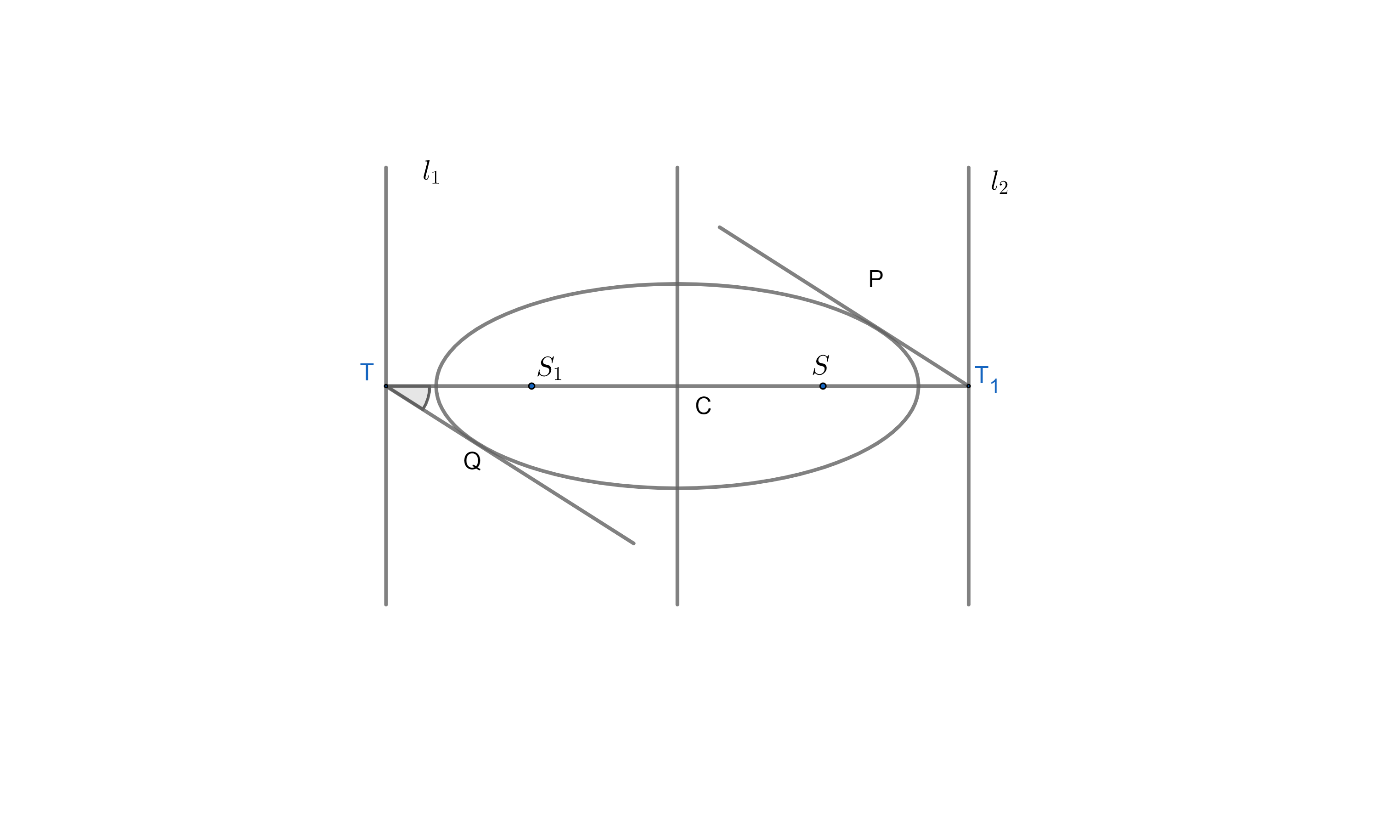
If two tangents to an ellipse and one of its foci be given, prove that the locus of its centre is a straight line.
Answer
596.1k+ views
Hint: Consider T as the tangent drawn to the ellipse. Use the equation to find the polar form of tangent. Take focus ‘S’ of the ellipse is (ae, 0) and for $s'$ $\left( -ae,0 \right)$. Find the polar form of Tangents to prove the locus of its centre is a straight line.
Complete step by step answer:
Let us consider $T$ as the tangent that is drawn to the ellipse. $TP$ and $TQ$ are the two tangents from $T$, which has their focus at $S.$ The focus $S$ of the ellipse is $\left( ae,0 \right)$ and for $S_1$ $\left( -ae,0 \right)$.
Hence we need to prove that $\angle QT{{S}_{1}}=\angle PTS$ ( from figure).

The centre $C$ of the ellipse is midway between S and ${{S}_{1}}$ , which are the focus.
Let the coordinate of any point be $\left( h,k \right)$ and equation to ellipse is
$\dfrac{{{x}^{2}}}{{{a}^{2}}}+\dfrac{{{y}^{2}}}{{{b}^{2}}}=1............\left( 1 \right)$
To find the polar form of tangent we have the equation $\dfrac{x{{x}_{1}}}{{{a}^{2}}}+\dfrac{y{{y}_{1}}}{{{b}^{2}}}=1..............\left( 2 \right)$
$\left( h,k \right)=\left( {{x}_{1}},{{y}_{1}} \right)$
$\therefore $ Substituting values in $\left( 2 \right)\Rightarrow \dfrac{xh}{{{a}^{2}}}+\dfrac{yk}{{{b}^{2}}}=1...........\left( 3 \right)$
By hypothesis $\Rightarrow \dfrac{1}{\sqrt{\dfrac{{{h}^{2}}}{{{a}^{2}}}+\dfrac{{{k}^{2}}}{{{b}^{2}}}}}=c$ is the length of perpendicular from centre $\left( 0,0 \right)$ is given this
On squaring and cross multiplying we get
$\dfrac{1}{2}=\dfrac{{{h}^{2}}}{{{a}^{4}}}+\dfrac{{{k}^{2}}}{{{b}^{4}}}$
Now generalizing the locus of $\left( h,k \right)$ , we get $\dfrac{{{x}^{2}}}{{{a}^{4}}}+\dfrac{{{y}^{2}}}{{{b}^{4}}}=\dfrac{1}{{{c}^{2}}}$
We got the locus of its centre, so when ${{S}_{1}}$ moves on $T{{S}_{1}}, C$ will move parallel to $T{{S}_{1}}$ so that they will bisect the line $S{{S}_{1}}$. Therefore we were able to prove that the locus of centre $C$ is a straight line.
Note: Remember that two tangents drawn from any point to an ellipse subtend equal angle at the focus.
Complete step by step answer:
Let us consider $T$ as the tangent that is drawn to the ellipse. $TP$ and $TQ$ are the two tangents from $T$, which has their focus at $S.$ The focus $S$ of the ellipse is $\left( ae,0 \right)$ and for $S_1$ $\left( -ae,0 \right)$.
Hence we need to prove that $\angle QT{{S}_{1}}=\angle PTS$ ( from figure).

The centre $C$ of the ellipse is midway between S and ${{S}_{1}}$ , which are the focus.
Let the coordinate of any point be $\left( h,k \right)$ and equation to ellipse is
$\dfrac{{{x}^{2}}}{{{a}^{2}}}+\dfrac{{{y}^{2}}}{{{b}^{2}}}=1............\left( 1 \right)$
To find the polar form of tangent we have the equation $\dfrac{x{{x}_{1}}}{{{a}^{2}}}+\dfrac{y{{y}_{1}}}{{{b}^{2}}}=1..............\left( 2 \right)$
$\left( h,k \right)=\left( {{x}_{1}},{{y}_{1}} \right)$
$\therefore $ Substituting values in $\left( 2 \right)\Rightarrow \dfrac{xh}{{{a}^{2}}}+\dfrac{yk}{{{b}^{2}}}=1...........\left( 3 \right)$
By hypothesis $\Rightarrow \dfrac{1}{\sqrt{\dfrac{{{h}^{2}}}{{{a}^{2}}}+\dfrac{{{k}^{2}}}{{{b}^{2}}}}}=c$ is the length of perpendicular from centre $\left( 0,0 \right)$ is given this
On squaring and cross multiplying we get
$\dfrac{1}{2}=\dfrac{{{h}^{2}}}{{{a}^{4}}}+\dfrac{{{k}^{2}}}{{{b}^{4}}}$
Now generalizing the locus of $\left( h,k \right)$ , we get $\dfrac{{{x}^{2}}}{{{a}^{4}}}+\dfrac{{{y}^{2}}}{{{b}^{4}}}=\dfrac{1}{{{c}^{2}}}$
We got the locus of its centre, so when ${{S}_{1}}$ moves on $T{{S}_{1}}, C$ will move parallel to $T{{S}_{1}}$ so that they will bisect the line $S{{S}_{1}}$. Therefore we were able to prove that the locus of centre $C$ is a straight line.
Note: Remember that two tangents drawn from any point to an ellipse subtend equal angle at the focus.
Recently Updated Pages
Master Class 12 Economics: Engaging Questions & Answers for Success

Master Class 12 Maths: Engaging Questions & Answers for Success

Master Class 12 Biology: Engaging Questions & Answers for Success

Master Class 12 Physics: Engaging Questions & Answers for Success

Master Class 8 Maths: Engaging Questions & Answers for Success

Class 8 Question and Answer - Your Ultimate Solutions Guide

Trending doubts
What is meant by exothermic and endothermic reactions class 11 chemistry CBSE

10 examples of friction in our daily life

One Metric ton is equal to kg A 10000 B 1000 C 100 class 11 physics CBSE

1 Quintal is equal to a 110 kg b 10 kg c 100kg d 1000 class 11 physics CBSE

Difference Between Prokaryotic Cells and Eukaryotic Cells

What are Quantum numbers Explain the quantum number class 11 chemistry CBSE




